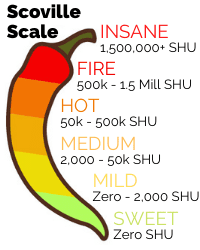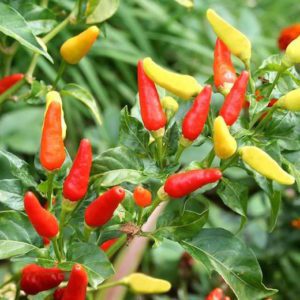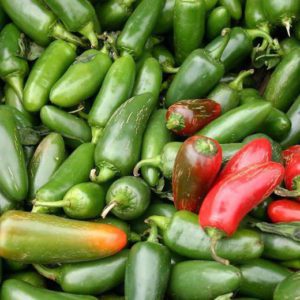If you want to add a touch of homegrown heat to your summertime recipes, here’s a list of our favorite peppers to grow in a home garden. For best results, peppers should be started indoors, about eight to ten weeks prior to last frost. However, most types of peppers are quick to grow and begin to produce fruits, so as long as you have eight to twelve weeks before cool weather rolls into town, you can grow your own hot peppers outdoors with little to no issues. Peppers are lovers of the sun, so be sure to plant them in an area that receives at least six to ten hours of direct sun per day. As your pepper plants begin to blossom, pinch off early growth to produce a higher yield and larger peppers.
Best Peppers for Home Gardeners
Some like it hot! Before you hit the heat, consider your audience. Does your family love to sweat and compete for who can stand the hottest pepper? Or do they all complain and drink mouthfuls of milk with every bite? The trusted Scoville Scale will help you identify what works best for your peppery peeps. It measures the heat level by Scoville Heat Units, or SHU, based on the concentration of pungency found in the pepper. A mild pepper rates around 700 whereas a crazy-hot pepper can be above 80,000 SHUs. Wow!

Habanero Pepper
This small, wrinkled orange pepper brings some serious heat for it’s small size, but also has a slightly sweet flavor that is best tasted when used fresh in a salsa or a salad. By cooking the Habanero pepper, it will help mellow out the heat and bring out the sweet flavor, but don’t let your guard down! They do require a warm environment to encourage sprouting, and can take up to three months to produce mature fruits. However, the popularity of the Habanero around the world is all the reason you should need to save a spot in your garden for these peppers.
Tabasco Pepper
This iconic pepper, best known for it’s use in the hot sauce with the same name, has a smoky, yet vinegary flavor, perfect to suit any BBQ. The Tabasco pepper gives gardeners a visual queue when they are ready by turning a bright red when they reach full maturation and are ready to be harvested. Tabasco is a perennial, but rarely lasts through two years of growth. To maximize your harvest each year, it’s best to start with a completely fresh crop.

Poblano Pepper
This beautiful dark green, almost black, pepper, is a mild chili that is the perfect complement to its hotter counterparts. The Poblano is excellent table fare, and is most commonly stuffed, like in chile rellenos. This bushy, easy to grow pepper, is one of the larger cultivars of peppers, and is often confused for a bell pepper. Because of their larger size, Poblano pepper bushes may require staking to support branches. If you’re planning to dry your Poblano harvest to make ancho chilis, leave the peppers on the vine until they are bright red in color.
Jalapeno Pepper
The easiest and fastest pepper to grow on the list is a staple found in gardens, and kitchens, everywhere. The Jalapeno pepper can reach maturity in as little as 75 days, perfect for gardeners in northern climates with shorter growing seasons. At harvest time, they are a brilliant green color, but can be left on the vine until red,which will mellow out the heat profile a bit. It is a versatile pepper than can be used raw, pickled, stuffed, or, a summertime picnic favor, wrapped in bacon!

Cayenne Pepper
Most of us keep a jar of cayenne pepper powder in our pantry, but growing your pepper from scratch allow you really hone in on the exact level of heat you’d like to add to your food. Growing a skinny fruit that reaches one to two inches in length, Cayenne peppers are fast producers, hitting maturity about two and a half months after sprouting. The Cayenne is another great candidate for the home garden that is limited on space, even a single plant that may only reach a foot and a half tall will produce more cayenne peppers than you’ll be able to use in a year.
Scotch Bonnet Pepper
You don’t need to be living on a Caribbean island to grow Scotch Bonnets, the pepper that helped make “jerk” food famous around the world. These little peppers actually look very similar to the Habanero, but the heat that is packed inside the small red fruits can often reach 300,000 or more on the Scoville scale, while Habaneros top out around 200,000. When harvest time comes around, about 2 and a half months after planting, be sure to wear gloves and eye protection, as the oils from the Scotch Bonnet pepper can irritate, and essentially burn, your skin or eyes.
Growing peppers in your garden is not only rewarding because of the bountiful harvest each plant provides, but it’s also a challenge for each home gardener to try to produce the hottest pepper possible! When the neighborhood block party or local chili cook-off comes around, you’ll have a fully stocked arsenal of hot pepper to really turn up the heat.